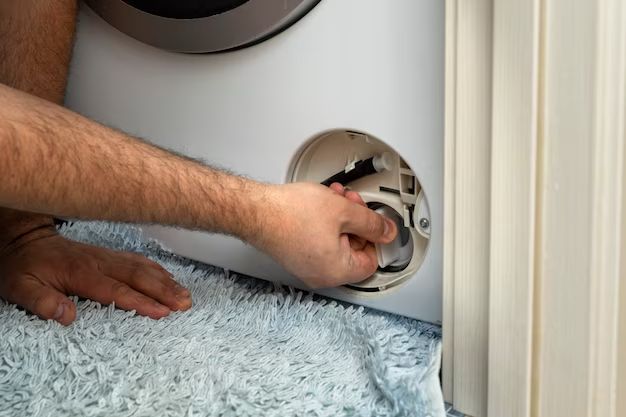Cleaning the inlet filter on a washing machine is an important maintenance task that should be done periodically to keep your washer running efficiently. The inlet filter screens out dirt and debris from the water entering your washing machine, preventing clogs and damage. Here is a step-by-step guide on how to clean this filter:
Page Contents
Why Clean the Inlet Filter?
There are a few key reasons you’ll want to clean the inlet filter:
- Removes built-up residue – Detergent, dirt, and mineral deposits from hard water can build up over time. Cleaning removes this residue.
- Improves water flow – Removes any obstructions so water can flow freely into the washer.
- Prevents clogs – Dirt and debris trapped in the filter can clog components like valves and hoses.
- Extends machine life – Regular filter cleaning protects the inner workings from unnecessary wear and tear.
Cleaning the filter every few months helps prevent problems and keep your washer working as efficiently as possible.
Preparing to Clean the Filter
Before you get started, you’ll need to take a few preparatory steps:
- Turn off your washing machine and unplug it from the power source.
- Turn off the water supply to your washing machine. This is usually done via shutoff valves behind the unit.
- Place a towel or bucket beneath the inlet hose to catch any water still in the line.
- Gather your supplies – rubber gloves, old toothbrush, vinegar, etc.
Turning off the power and water ensures safety throughout the process. The towel or bucket collects any residual water in the hose so it doesn’t spill out when you remove the filter.
Locating the Inlet Filter
Washing machine inlet filters are typically located along the fill hose that connects to your home’s water supply. The specific location can vary by model. Common locations include:
- Where the inlet hose meets the washer backsplash
- Behind the washer control panel
- Inside the washer cabinet under a panel or cover
- Where the hose attaches at shutoff valve or faucet
Consult your owner’s manual if you’re having trouble finding the filter. For top loaders, it’s often under a panel in the back corner. For front loaders, check behind the control panel or along the fill hose.
Removing the Filter from the Housing
Once located, removing the filter takes just a few simple steps:
- Loosen the inlet hose from the threaded filter housing. You may need pliers for gripping and turning.
- Unscrew the housing counterclockwise to loosen it. It may be plastic or metal.
- Pull the housing off and remove the filter screen inside. Rinse it off under water.
Take care not to damage any rubber gaskets or washers when separating the housing. Also, the initial rush of trapped water can splash out when unthreaded, so keep that towel handy.
Cleaning the Filter Screen
With the filter removed, it’s time to clean. Give it a good rinse under warm water. Use an old toothbrush or brush to scrub away any stuck-on deposits.
For mineral buildup, soak the filter in white vinegar for 15-20 minutes. Baking soda or lemon juice also help dissolve deposits. Rinse thoroughly after soaking.
Check the filter closely while cleaning. Make sure to remove all residue for optimal water flow. Repeat soaking or scrubbing if needed to fully clean the screen mesh.
Reinstalling the Filter
Once cleaned, put the filter screen back into the threaded housing. Screw the housing clockwise back onto the fill hose or valve opening. Tighten it securely, but be careful not to overtighten.
Turn the water supply back on and check for leaks. If leaks occur, tighten slightly or reseat the gasket. The washer can then be plugged back in and run normally.
Tips for Easy Filter Cleaning
- Clean the filter 2-3 times per year for maintenance.
- Schedule cleaning when the washer is already being serviced.
- Place a sticky note or reminder on your machine when it’s time.
- Lay down towels to catch water drips and splashes.
- Have pliers ready to loosen tight hoses or housings.
When to Call a Professional
While DIY maintenance saves on repair costs, there are some cases where a technician should handle filter cleaning:
- You can’t access the filter on your model.
- The hose or housing threads are corroded.
- There are leaks you can’t stop by tightening.
- Mineral buildup requires descaling the valves or hoses.
- The filter is torn, warped, or otherwise damaged.
If you encounter any of these issues, call an appliance repair technician to service your washing machine and inlet filter.
Conclusion
Keeping your washing machine inlet filter clean improves performance and can prevent costly repairs. Just follow these steps:
- Turn off power and water to the washer.
- Locate the filter along the fill hose.
- Remove the threaded filter housing.
- Clean debris and mineral buildup off the filter screen.
- Reinstall the filter housing securely.
- Restore power and water to test for leaks.
Take a few minutes every 3-6 months to clean your filter. This simple maintenance keeps your washer running smoothly for years to come.
